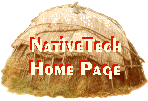
© 1994 - Tara Prindle
unless otherwise cited.
Indian Corn
Corn was a very important crop for the people of the northeast woodlands. It was the main food and was eaten at every meal. There were many varieties of corn -- white, blue, yellow and red.
Some of the corn was dried to preserve and keep it for food throughout the winter months. Dried corn could be made into a food called hominy. To make hominy, the dried corn was soaked in a mixture of water and ashes for two days. When the kernels had puffed up and split open, they were drained and rinsed in cold water. Then the hominy was stir-fried over a fire. You can buy canned hominy in most grocery stores. Perhaps someone in your class would like to bring some for everyone to sample.
Corn was often ground into corn meal, using wooden mortars and pestles. The mortars were made of short logs which were turned upright and hollowed out on the top end. The corn was put in the hollow part and ground by pounding up and down with a long piece of wood which was rounded on both ends. This was called a pestle.
Corn meal could be used to make cornbread, corn pudding, corn syrup, or could be mixed with beans to make succotash. A special dessert was made by boiling corn meal and maple syrup.
All parts of the corn plant were used. Nothing was thrown away. The husks were braided and woven to make masks, moccasins, sleeping mats, baskets, and cornhusk dolls. Corncobs were used for fuel, to make darts for a game, and were tied onto a stick to make a rattle for ceremonies.
Corn was unknown to the Europeans before they met the Indians. Indians gave them the seeds and taught them how to grow it. Today in the U.S.A., more farm land is used to grow corn (60 million acres) than any other grain.
From: Woodland Culture Area, Ross/Fernandes, 1979

|
Text and Graphics
© 1994 - Tara Prindle unless otherwise cited. |